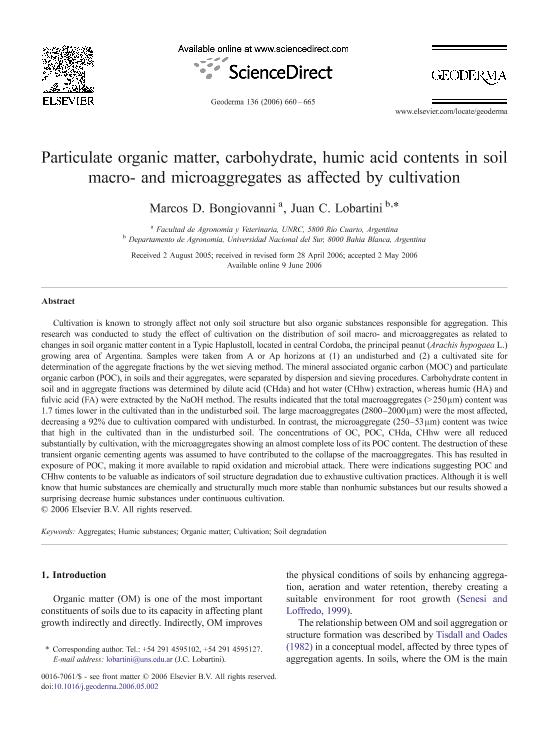Mostrar el registro sencillo del ítem
dc.contributor.author
Bongiovanni, Marcos D.
dc.contributor.author
Lobartini, Juan Carlos

dc.date.available
2020-01-09T20:43:18Z
dc.date.issued
2006-12
dc.identifier.citation
Bongiovanni, Marcos D.; Lobartini, Juan Carlos; Particulate organic matter, carbohydrate, humic acid contents in soil macro- and microaggregates as affected by cultivation; Elsevier Science; Geoderma; 136; 3-4; 12-2006; 660-665
dc.identifier.issn
0016-7061
dc.identifier.uri
http://hdl.handle.net/11336/94242
dc.description.abstract
Cultivation is known to strongly affect not only soil structure but also organic substances responsible for aggregation. This research was conducted to study the effect of cultivation on the distribution of soil macro- and microaggregates as related to changes in soil organic matter content in a Typic Haplustoll, located in central Cordoba, the principal peanut (Arachis hypogaea L.) growing area of Argentina. Samples were taken from A or Ap horizons at (1) an undisturbed and (2) a cultivated site for determination of the aggregate fractions by the wet sieving method. The mineral associated organic carbon (MOC) and particulate organic carbon (POC), in soils and their aggregates, were separated by dispersion and sieving procedures. Carbohydrate content in soil and in aggregate fractions was determined by dilute acid (CHda) and hot water (CHhw) extraction, whereas humic (HA) and fulvic acid (FA) were extracted by the NaOH method. The results indicated that the total macroaggregates (> 250 μm) content was 1.7 times lower in the cultivated than in the undisturbed soil. The large macroaggregates (2800-2000 μm) were the most affected, decreasing a 92% due to cultivation compared with undisturbed. In contrast, the microaggregate (250-53 μm) content was twice that high in the cultivated than in the undisturbed soil. The concentrations of OC, POC, CHda, CHhw were all reduced substantially by cultivation, with the microaggregates showing an almost complete loss of its POC content. The destruction of these transient organic cementing agents was assumed to have contributed to the collapse of the macroaggregates. This has resulted in exposure of POC, making it more available to rapid oxidation and microbial attack. There were indications suggesting POC and CHhw contents to be valuable as indicators of soil structure degradation due to exhaustive cultivation practices. Although it is well know that humic substances are chemically and structurally much more stable than nonhumic substances but our results showed a surprising decrease humic substances under continuous cultivation.
dc.format
application/pdf
dc.language.iso
eng
dc.publisher
Elsevier Science

dc.rights
info:eu-repo/semantics/openAccess
dc.rights.uri
https://creativecommons.org/licenses/by-nc-nd/2.5/ar/
dc.subject
AGGREGATES
dc.subject
CULTIVATION
dc.subject
HUMIC SUBSTANCES
dc.subject
ORGANIC MATTER
dc.subject
SOIL DEGRADATION
dc.subject.classification
Otras Ciencias Agrícolas

dc.subject.classification
Otras Ciencias Agrícolas

dc.subject.classification
CIENCIAS AGRÍCOLAS

dc.title
Particulate organic matter, carbohydrate, humic acid contents in soil macro- and microaggregates as affected by cultivation
dc.type
info:eu-repo/semantics/article
dc.type
info:ar-repo/semantics/artículo
dc.type
info:eu-repo/semantics/publishedVersion
dc.date.updated
2019-11-25T18:43:36Z
dc.journal.volume
136
dc.journal.number
3-4
dc.journal.pagination
660-665
dc.journal.pais
Países Bajos

dc.journal.ciudad
Amsterdam
dc.description.fil
Fil: Bongiovanni, Marcos D.. Universidad Nacional de Río Cuarto; Argentina
dc.description.fil
Fil: Lobartini, Juan Carlos. Consejo Nacional de Investigaciones Científicas y Técnicas. Centro Científico Tecnológico Conicet - Bahía Blanca; Argentina. Universidad Nacional del Sur. Departamento de Agronomía; Argentina
dc.journal.title
Geoderma

dc.relation.alternativeid
info:eu-repo/semantics/altIdentifier/url/https://www.sciencedirect.com/science/article/pii/S0016706106001613
dc.relation.alternativeid
info:eu-repo/semantics/altIdentifier/doi/http://dx.doi.org/10.1016/j.geoderma.2006.05.002
Archivos asociados
